Distinctive cabbage-trees have succulent stems and large compound leaves that characteristically crowd at the end of branches. Endemic to Africa, Yemen and the Comoro Islands, due to their strong architectural form some species are cultivated as garden plants.

One of these species is the mountain cabbage tree (Cussonia paniculata), shown above growing in the Drakensberg region of KwaZulu-Natal. As the trees mature they can acquire a gnarled appearance making them an interesting feature plant in a garden.

The long leaves of the mountain cabbage-tree, often greenish-blue in colour, cluster at the end of branches. New leaf growth is reddish in colour. The soft wood of the mountain cabbage-tree used to be used to make brake-blocks for wagons.
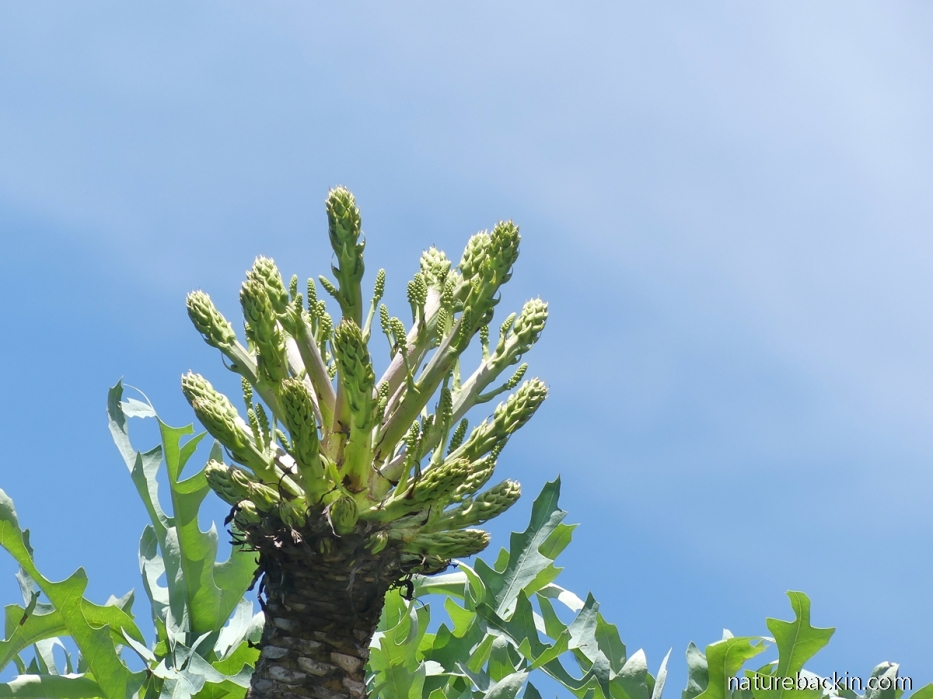
Flowers on long stems (spikes) also cluster at the end of branches and typically emerge from January to March. The photo above of developing flowers on a mountain cabbage-tree was taken in January in our garden. Flowers are pollinated by a variety of flying insects, notably by bees, wasps and flies, which are attracted by the smelly nectar.
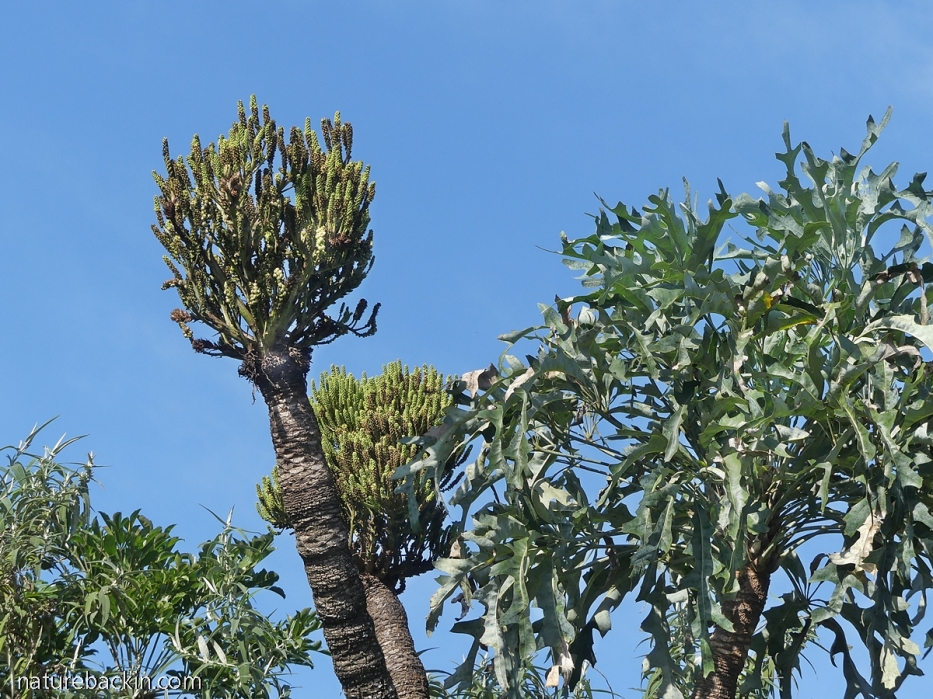
The flower stems start fruiting a few months after the first flowering. Above is a photo of the same flower stem in March of the same year as the fruits start maturing.
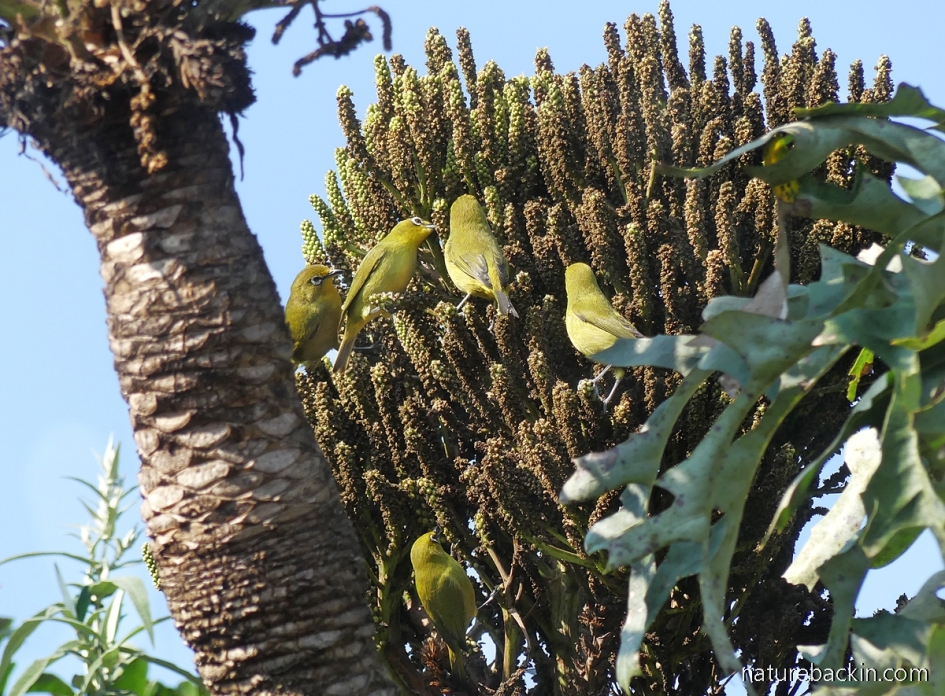
As the fruits ripen they attract the attention of birds such as these Cape white-eyes (Zosterops capensis) that were foraging in a small group. Cabbage-trees in the garden provide not only a virtual feast for our appreciative eyes but also a literal feast for insects, birds and other creatures too.
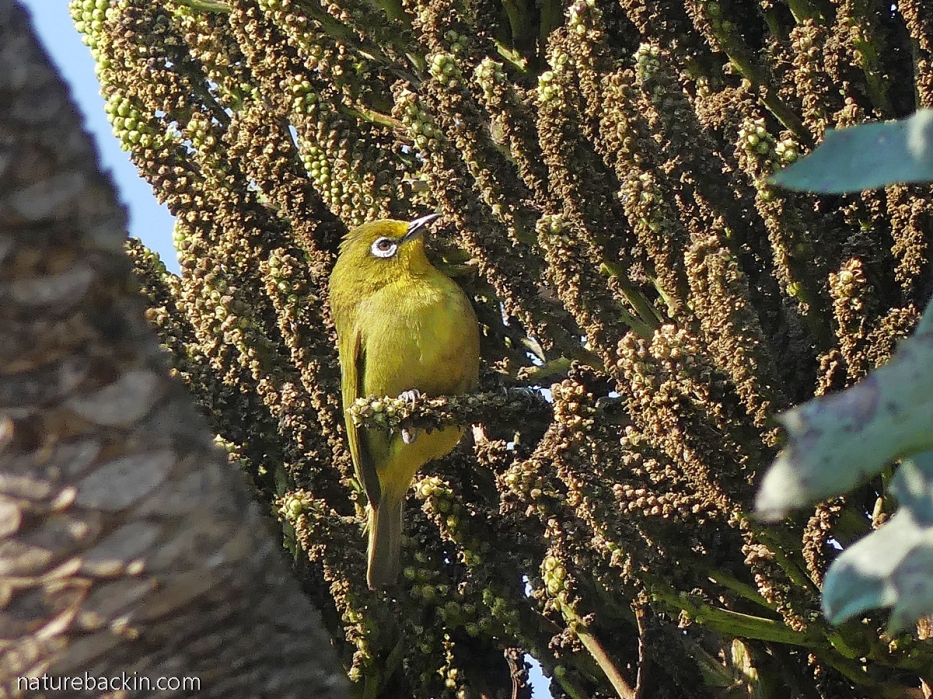
The SANBI entry on the mountain cabbage-tree states that birds eat small black seeds from the ripened fruits.
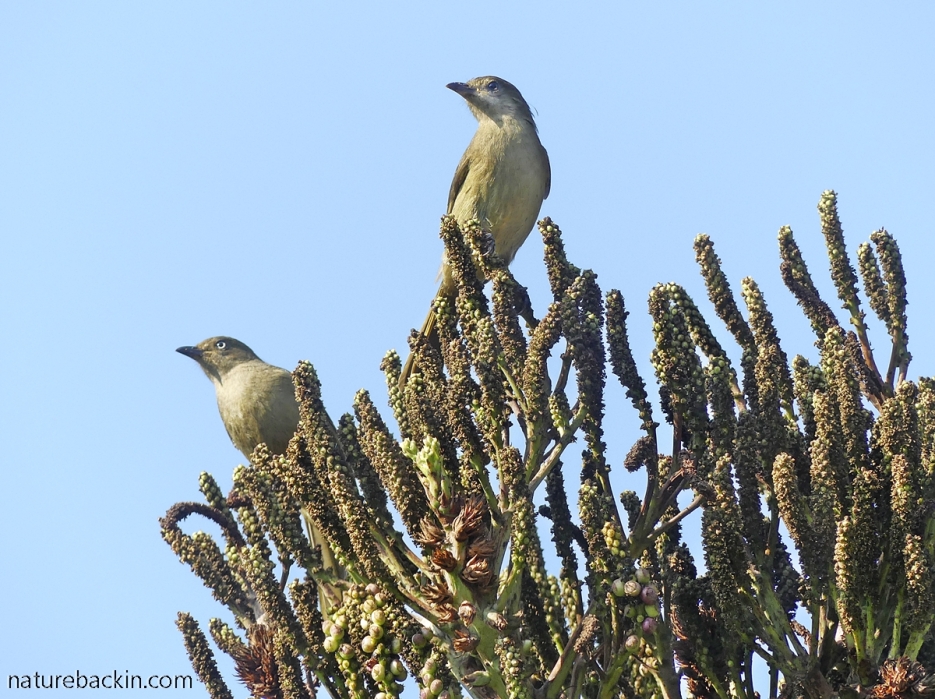
Also in our garden, the mountain cabbage-tree attracted a pair of sombre bulbuls (Andropadus importunus) that visited to feed on the ripe fruits.

The common name ‘cabbage-tree’ may be due to the blue-green colour of the leaves of some species, such as the mountain cabbage-tree, as the colour is similar to the colour of cabbage leaves. The leaves of the mountain cabbage-tree are characteristically long and droopy.
There are three species of cabbage tree planted in our garden – the mountain cabbage-tree (Cussonia paniculata) and the common cabbage-tree (Cussonia spicata), which are the mostly commonly cultivated species, plus a third species more unusual as a garden plant, this being the Zulu cabbage-tree (Cussonia zuluensis). We are fortunate to have inherited these trees, which were planted by the previous owners of our property who were kind enough to give us list of the indigenous trees that they established in the garden.
The mountain cabbage-tree is distinctive enough with its relatively pale and long leaves for me to identify, but I was less certain of identifying the other two species, but examining the leaves helped me to decide which was which.
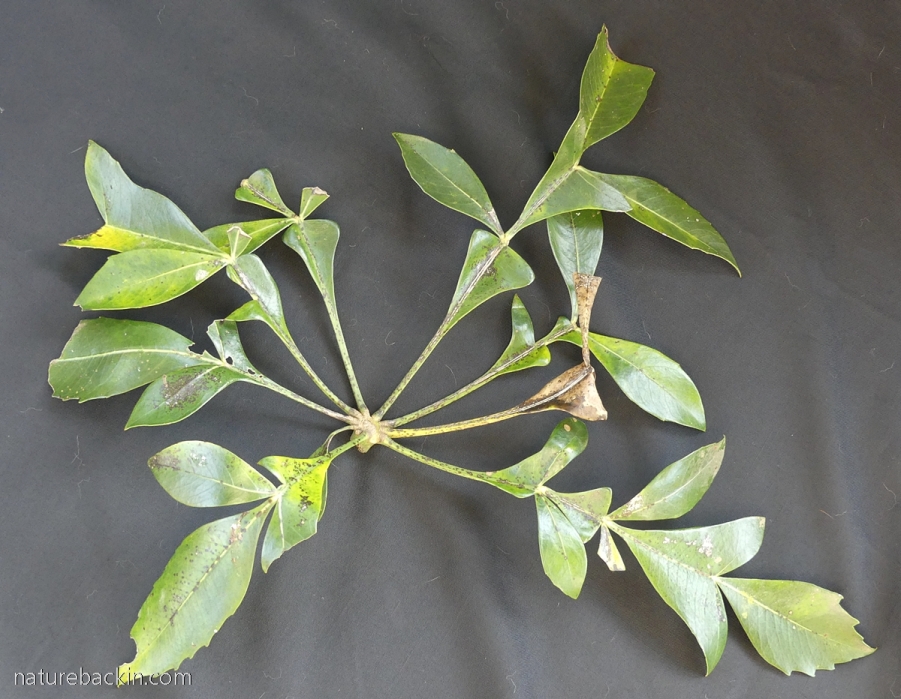
Here are some leaves of the common cabbage-tree (Cussonia spicata), which my tall spouse plucked from one of the trees in the garden with the help of a long pole with a hook on the end.
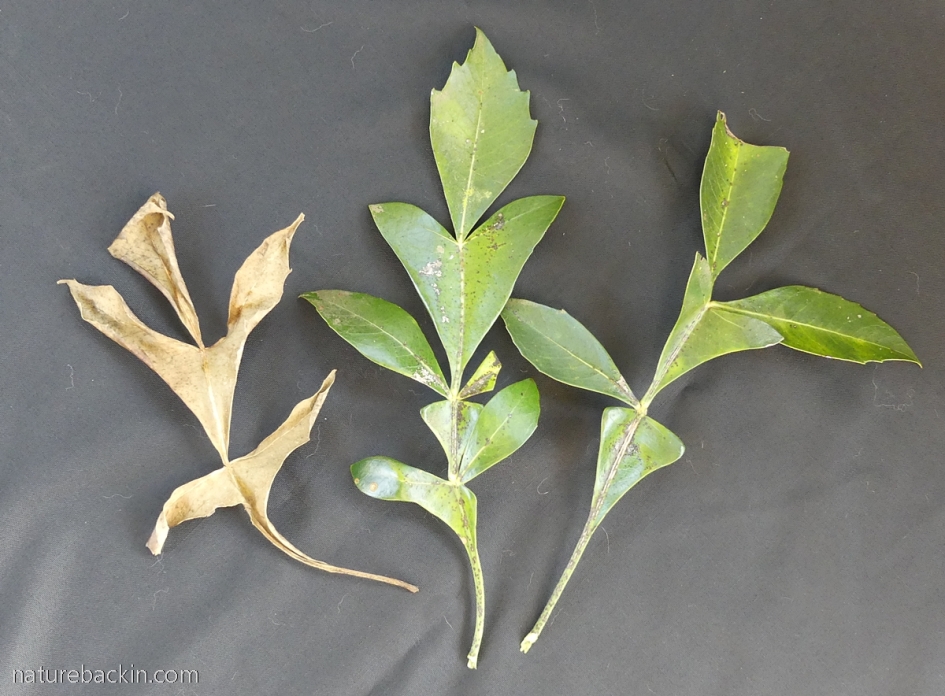
Above are three individual leaves with the dry leaf at the left collected from leaves that had fallen to the ground naturally. The leaves can be quite variable, but essentially they have a twice compound shape.
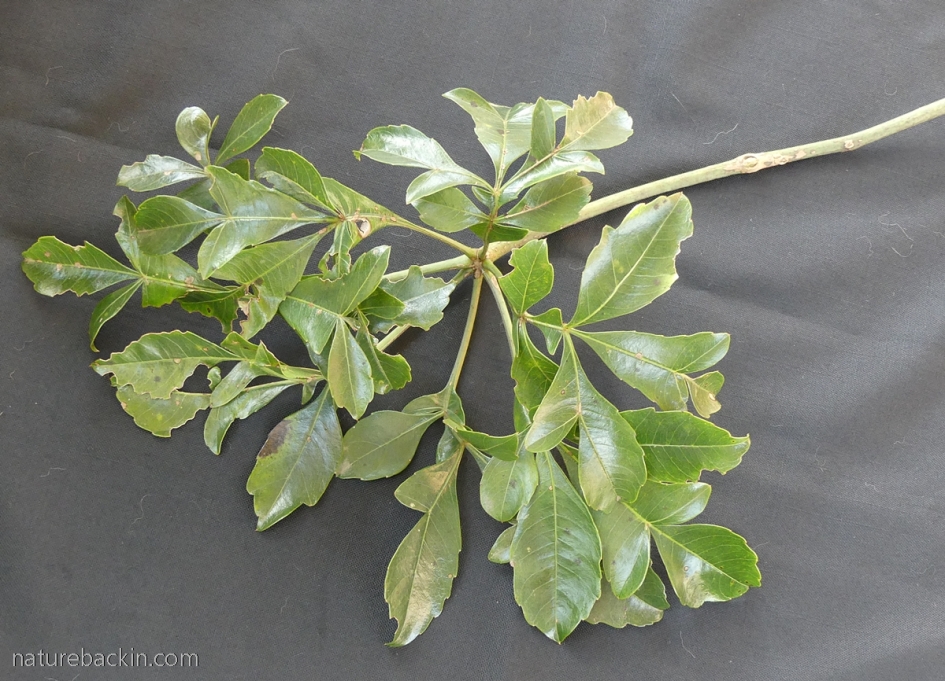
The leaves of the Zulu-cabbage tree (Cussonia zuluensis) are considerably smaller and slightly more complex in shape.
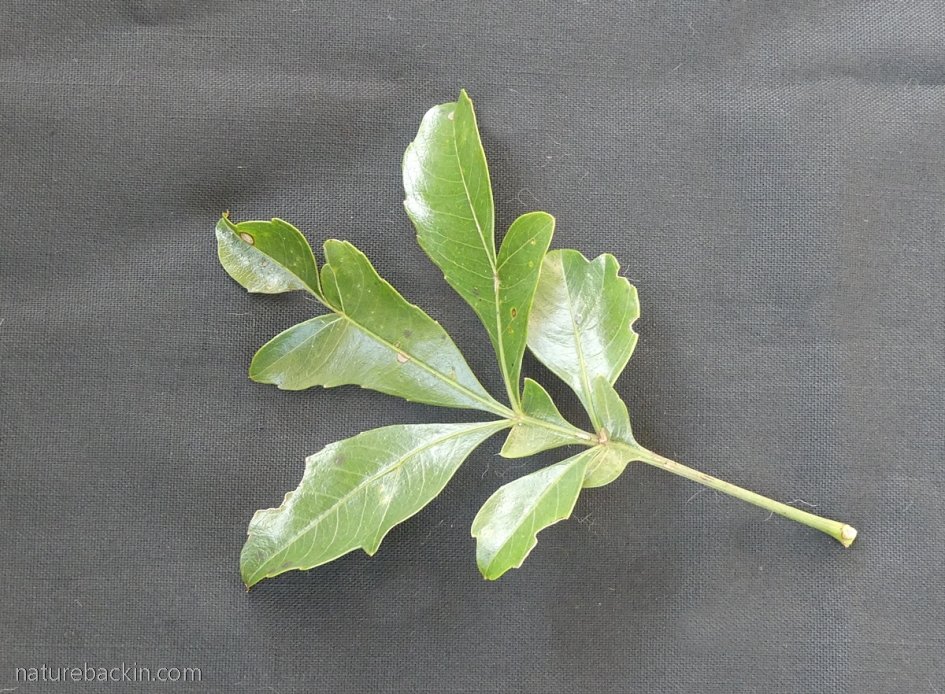
Above is a single leave from the Zulu cabbage-tree, also showing a double compound structure.
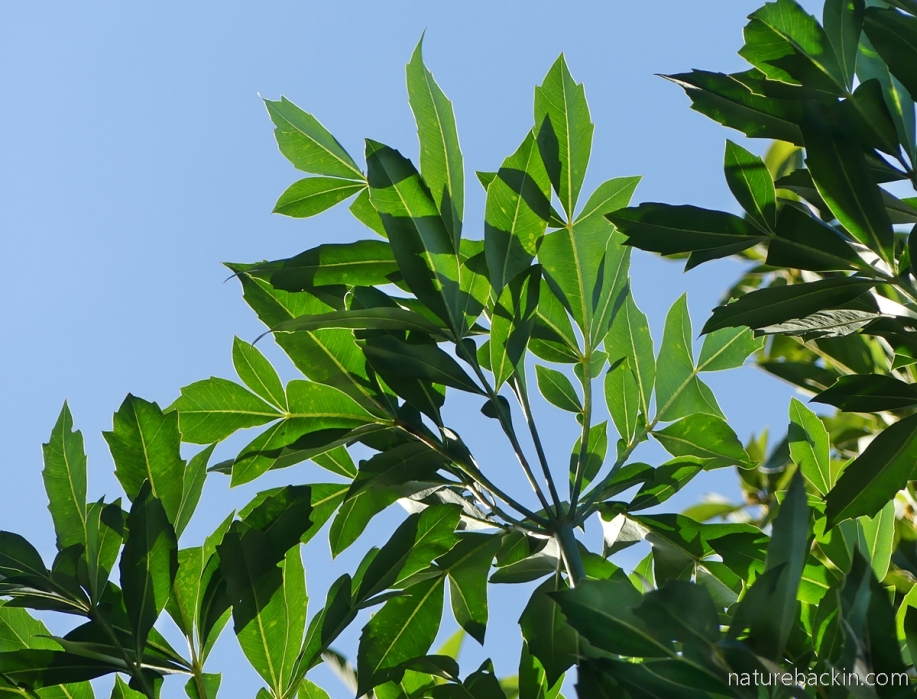
This is what the leaves of a fairly young common cabbage-tree (Cussonia spicata), look like silhouetted against the sky when photographed from below. This tree apparently was self-seeded from an older tree that was deliberately planted in the garden.
Cabbage-trees are known to have invasive root systems. We discovered this to our cost when we found that the roots of a common cabbage-tree that had been planted close to a corner of our house were damaging the buried water pipes that bring water to the house. Digging down we found the roots wound around the pipes in a damaging embrace, so sadly we had to remove the tree. Luckily though we found a self-seeded seedling growing nearby, so we dug it up and planted it in a pot where it thrived.

Taken in August 2011, the then small potted cabbage-tree sprouted a fresh group of glossy leaves in the spring.
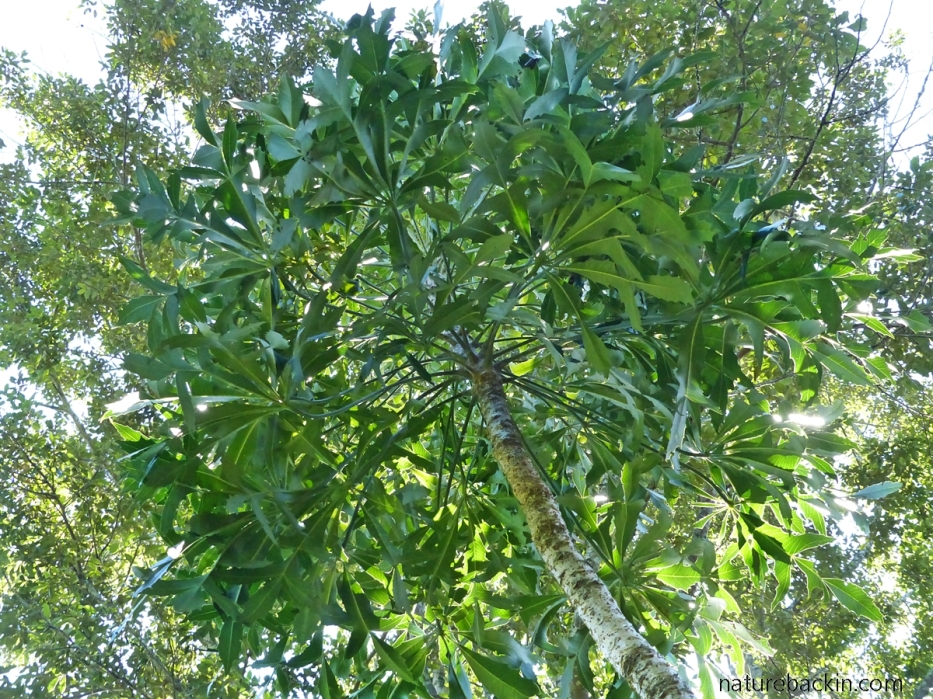
After outgrowing its pot, we transplanted the tree to a spot in the garden far enough away from any structures or plumbing! The above photo was taken in March 2019. The tree has a single slender stem and the tree is now about 8 metres (26 feet) tall. Common cabbage-trees can grow to heights of between 10 and 15 metres (32 and 49 feet) or even taller at maturity.

I took the above photo using my cellphone when walking on the margins of the plantation near our house. This tree may be the common cabbage-tree (Cussonia spicata), but it could also be the forest cabbage-tree (Cussonia sphaerocephala), which are recorded as growing in forest patches in our area. There are about 19 species of Cussonia occurring naturally in Africa, with 9 species occurring in South Africa.

This photo I took looking up at the Zulu cabbage-tree (Cussonia zuluensis) in our garden. Some of its flowering/fruiting spikes are visible.
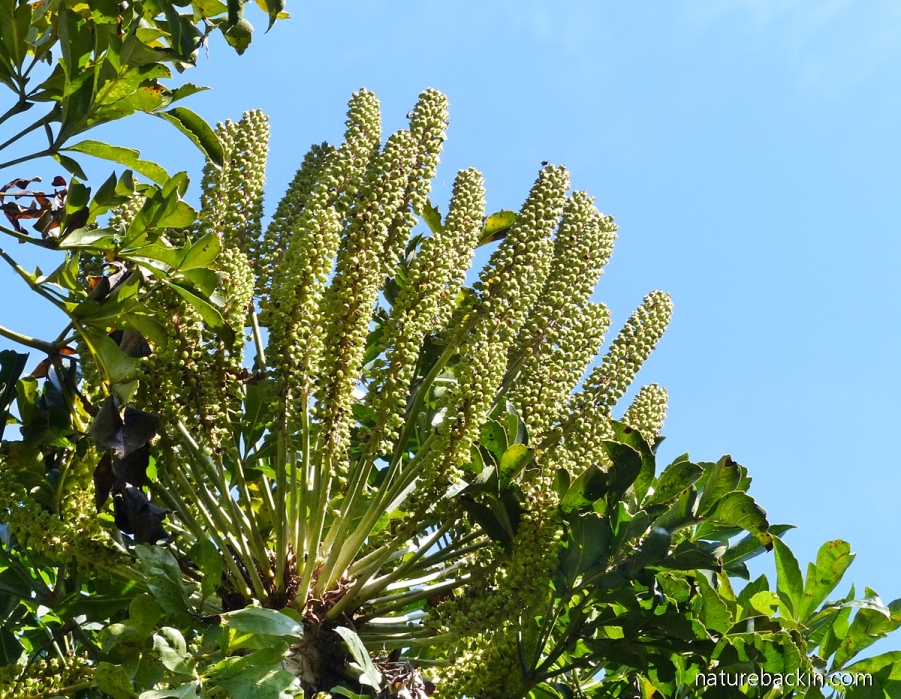
Above is a closer view of a cluster of the pale green flowering spikes.
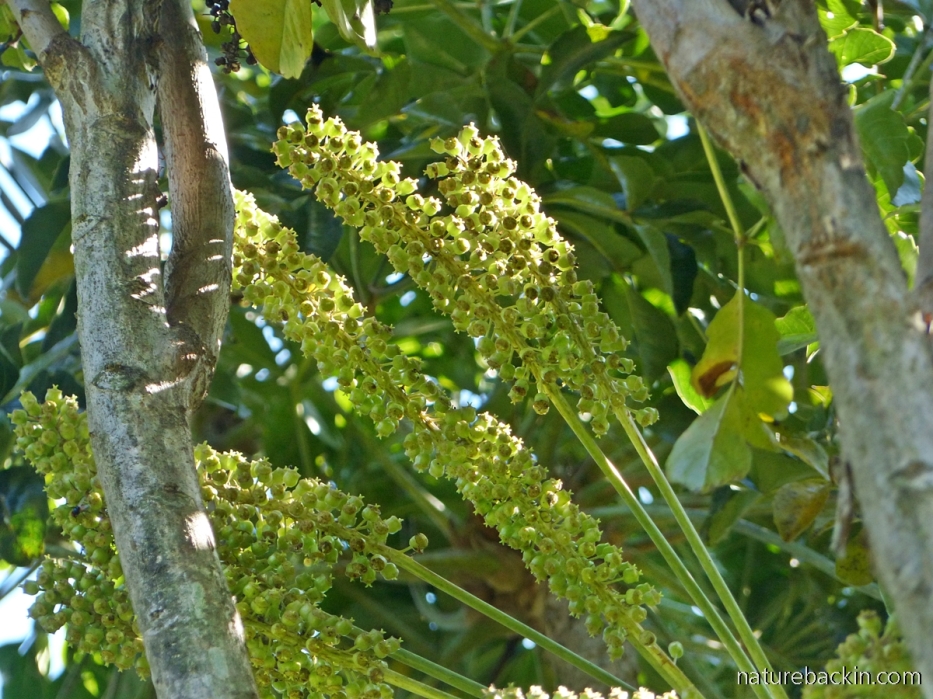
And a closer view still of the small greenish-yellow flowers clustered on stalks.
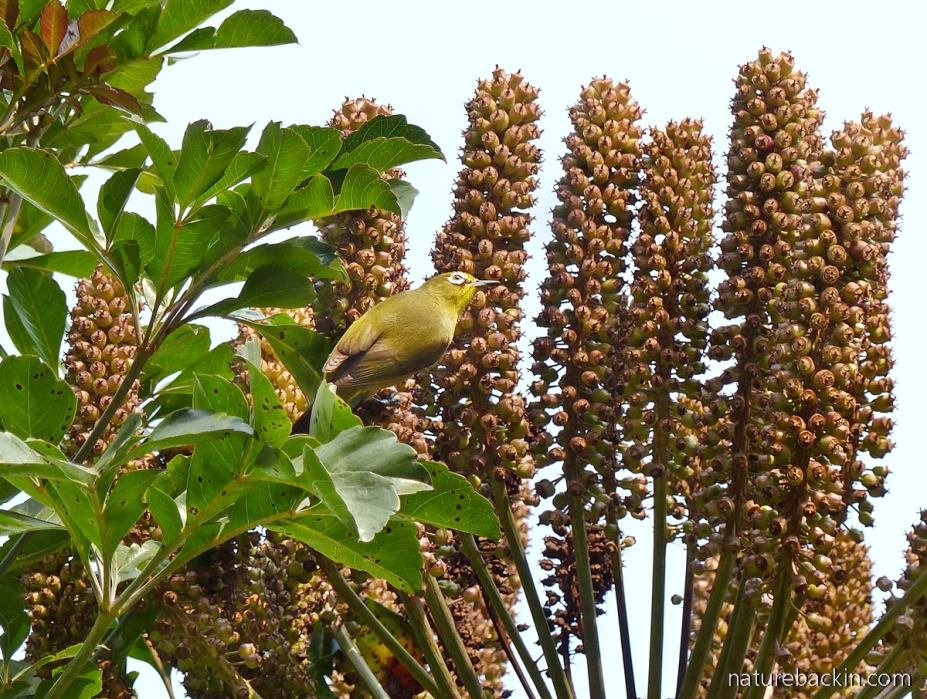
The fruits ripen to a mauvish colour and attract the attention of birds, such as this Cape white-eye.

This sombre bulbul spent some time tucking into the fruits on the Zulu cabbage-tree (Cussonia zuluensis) in our garden.
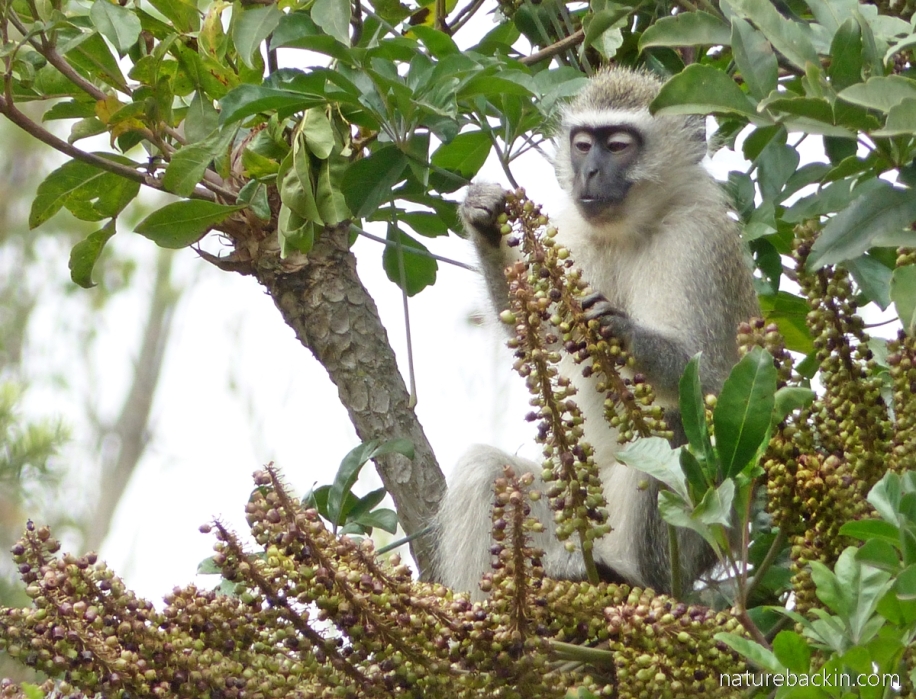
Vervet monkeys (Chlorocebus pygerythrus) also enjoy eating the fruits on this cabbage-tree. From a distance, I watched this monkey who foraged on his own, carefully picking off fruit one at time to savour.
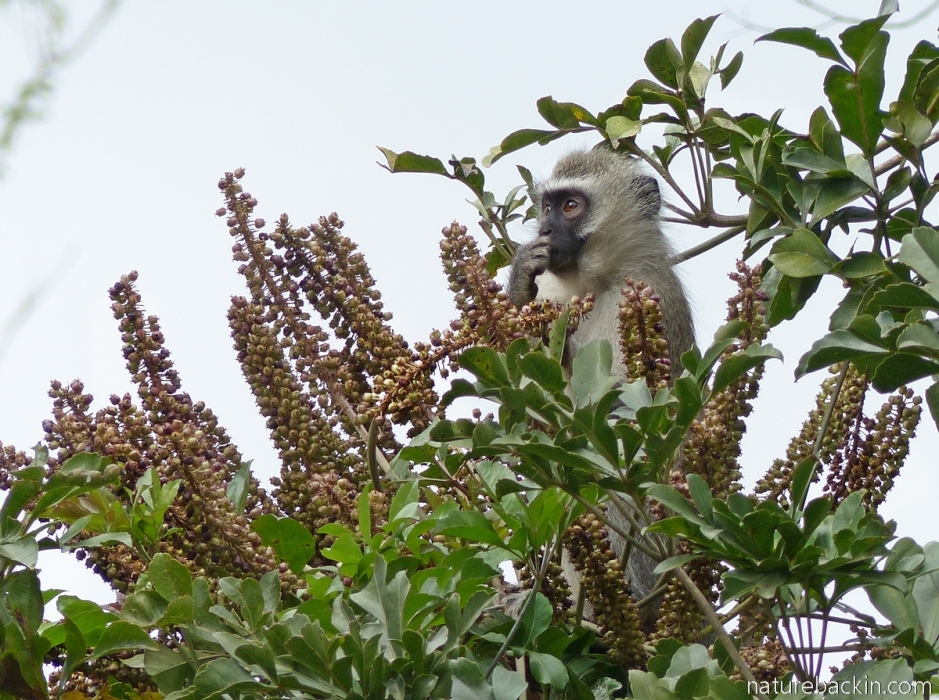
The monkey was very alert while high up in the tree and I kept a discreet distance when taking these photos using the zoom lens.

The monkey kept scanning the skies from his rather exposed position reminding me of his vulnerability to predators, including to Crowned Eagles (Stephanoaetus coronatus) that reside in our area. Vervet monkeys play an important role as seed dispersers of many indigenous plants.

New growth in early summer – a coronet of red leaves sprouting from one of the tops of the Zulu cabbage-tree (Cussonia zuluensis) in our garden.
Sources:
Boon, Richard. 2010 (2nd ed.). Pooley’s Trees of Eastern South Africa. Durban: Flora & Fauna.
SANBI. [n.d.] Cussonia. SA National Biodiversity Institute. http://pza.sanbi.org/plants/search/advanced?pow_page=genus&name=Cussonia
Posted by Carol



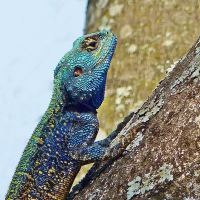
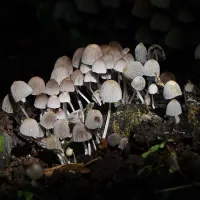

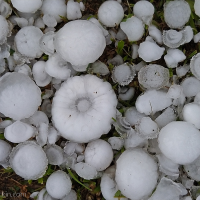
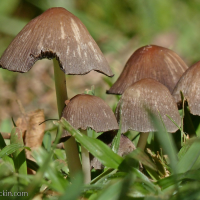

June 26, 2022 at 1:30 am
So much exotic greenery in your beautiful part of the world, Carol! A lovely post. Of course, I get totally sidetracked every time you post those amazing Vervets. 😉 That first picture was especially touching. Hope you are well, and thank you for providing me with an uplifting focus during these trying times in my country.
Regards,
Julie
LikeLiked by 1 person
June 26, 2022 at 6:58 pm
Thanks Julie. Yes the vervets really are amazing.
I am so sorry about the trying times in the US. It is all very concerning and the repercussions will spread far and wide.
We all need all the distractions we can get to help us keep on keeping on.
Sending best wishes.
LikeLiked by 1 person
June 19, 2022 at 4:37 pm
I am fond of these trees and we also have one in our garden. Thank you for the rich information in this post. I will look at ours more carefully, especially during fruiting time early next year
LikeLiked by 1 person
June 23, 2022 at 9:01 pm
Glad to know you also have one in your garden to enjoy. Sometimes the fruits are so high up and concealed they are not easy to see and appreciate!
LikeLiked by 1 person
June 18, 2022 at 4:36 am
Interesting stuff, Carol. I love those flower stems. How nice it is that they attract so much wildlife.
LikeLiked by 1 person
June 19, 2022 at 4:06 pm
Thanks Graham – the flowers and fruits are particularly fascinating. Its great to be able to spend time watching the birds foraging in the trees.
LikeLiked by 1 person
June 17, 2022 at 5:59 pm
What an interesting and valuable tree. It’s beautiful to look upon and such a great bonus that it attracts so many different birds and animals. Great natural history post of this plant. Thanks for sharing it, Carol!
LikeLiked by 1 person
June 19, 2022 at 4:04 pm
Thanks Steve – I enjoyed sharing these special trees and some of their visitors.
LikeLiked by 1 person
June 17, 2022 at 3:27 pm
Cabbage trees. Who knew? I’d never come across these, but they look a fascinating addition to your local tree life. Local animal life seems to agree!
LikeLiked by 1 person
June 19, 2022 at 4:04 pm
‘Cabbage tree’ is a rather strange naming! They are unique and interesting additions to the garden, made even more special by attracting so many animals.
LikeLiked by 1 person
June 17, 2022 at 5:34 am
I am enjoying looking at the cabbage trees growing in the wild around here at the moment. Many are putting out fresh leaves whilst others are fruiting. I was given one as a tiny seedling years ago and planted it (quite ignorant of its growth habits) rather close to our swimming pool – it is fairly tall already and I keep hoping it has decided to send its roots elsewhere! Your photographs of the Cape White-eyes enjoying the fruits are delightful – as are those of the monkey.
LikeLiked by 1 person
June 19, 2022 at 3:57 pm
That is interesting that the wild trees are already putting out fresh leaves.
Hopefully the roots of the cabbage tree will avoid the swimming pool!
It is lovely to see the birds and monkeys enjoying the fruits. Woodpeckers sometimes forage on the fissured bark but I don’t have a photo of that as yet.
LikeLiked by 1 person
June 17, 2022 at 4:21 am
Love Cussonia. Especially the new red leaves in spring.
LikeLiked by 1 person
June 19, 2022 at 3:54 pm
Thanks Nikki – the red leaves in spring are a surprising additional appealing feature.
LikeLike
June 17, 2022 at 3:42 am
Thank you for introducing me to this interesting family of trees, Carol. It’s nice to see how many animals make use of their offerings.
LikeLiked by 1 person
June 19, 2022 at 3:52 pm
Thanks Tanja. They are interesting trees and it is such a bonus that they attract so many animals.
LikeLiked by 1 person
June 17, 2022 at 3:02 am
Dear Carol, Cabbage trees are one of my favourites! Your post is excellent and lovely to see your photos of the flowers. I have grown one in my garden with great success, though we also have them occurring naturally here! xxx
LikeLiked by 1 person
June 19, 2022 at 3:50 pm
Hi Christeen, you are lucky to have them growing naturally around you but it is also special to have one in the garden, They are beautiful and distinctive trees.
xxx
LikeLiked by 1 person
June 16, 2022 at 10:15 pm
These trees are unlike anything I’ve seen before, I love the leaf shapes and the way the head of the tree grows. What a variety of wildlife that come to visit your garden, a great way to encourage wildlife around the community to have a resource of food available to them.
LikeLiked by 1 person
June 19, 2022 at 3:48 pm
They are unusual trees – quite prehistoric looking in some ways. That they provide food for a variety of wildlife certainly adds to their value.
LikeLiked by 1 person
June 16, 2022 at 9:59 pm
An attractive genus, they are a handsome tree. I can see why they are popular. A bonus that it also is a treat for wildlife.
Your plumbing issue reminds me of weeping willows here, which are notorious in wreaking havoc with water pipes. They have a great appetite for water and are often used to dry up wet areas, but never should be planted near a house.
That vervet monkey is so cute, but I know they can be mischievous!
LikeLiked by 1 person
June 19, 2022 at 3:46 pm
Weeping willows have naturalised in farmlands in some regions in SA. I did not know that they too have invasive roots.
We really enjoy our cabbage trees and all the life they attract,
LikeLike